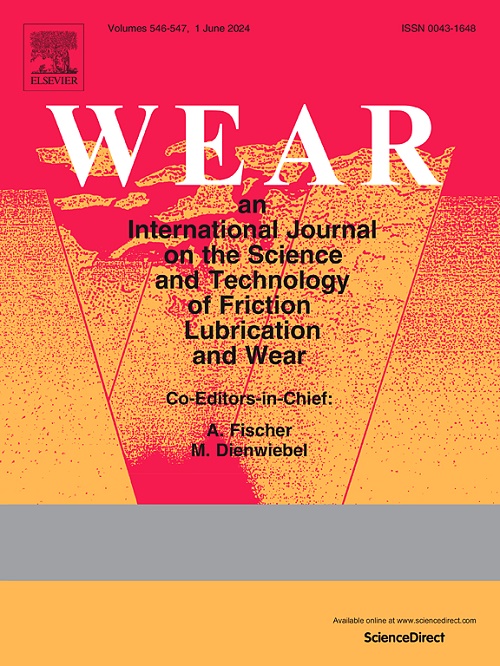基于节点改进的铁路压合轴微动疲劳耗散模型研究
IF 5.3
1区 工程技术
Q1 ENGINEERING, MECHANICAL
引用次数: 0
摘要
车轴作为高速列车运行系统的关键部件,对高速列车的安全运行起着至关重要的作用。目前对轴类微动磨损与疲劳发展的研究存在磨损模型局部仿真精度低、缺乏对磨损与疲劳动态扩展的检测和验证方法等问题。为此,本研究首先提出了一种新的节点改进形式的耗能磨损模型,该模型对过填充区粗糙体的接触行为和能量传递过程更为敏感;该模型的磨损预测结果比传统模型更接近实际情况,提高了循环时间与磨损疲劳裂纹扩展对应关系的预测精度。其次,提出了动态旋转下轴磨损疲劳声发射深度学习检测与验证方法;利用轴动态旋转实验建立75,480个磨损疲劳信号时频图数据集,训练卷积自编码器和多头注意机制识别检测网络。对磨损疲劳损伤阶段的识别准确率达到87.4%。研究表明,节点改进的能量耗散模型结合声发射动态旋转磨损疲劳检测可以准确评估轴微动磨损对疲劳发展的影响。本文章由计算机程序翻译,如有差异,请以英文原文为准。

Research on node-improved energy dissipation wear model for fretting fatigue prediction in railway press-fit shaft
As a key component of the traveling system of high-speed trains, the axle is crucial for its safe operation. The current research on the fretting wear and fatigue development of shafts suffers from the problems of low local simulation accuracy of the wear model and the lack of detection and validation methods for the dynamic expansion of wear and fatigue. To this end, this study firstly proposes a new node-improved form of energy dissipation wear model, which is more sensitive to the contact behavior of the asperity body in the overfilled region and the energy transfer process; it exhibits wear prediction results that are closer to the actual situation than the traditional model and improves the prediction accuracy of the corresponding relationship between the cycle time and the wear fatigue crack extension. Secondly, the acoustic emission deep learning detection and validation method of shaft wear fatigue under dynamic rotation is developed; 75,480 wear fatigue signal time-frequency map datasets are established with shaft dynamic rotation experiments, and the convolutional self-encoder and multi-head attention mechanism recognition and detection network are trained. The recognition accuracy of the wear fatigue damage stage reaches 87.4 %. This study shows that the node-improved energy dissipation model combined with acoustic emission dynamic rotation wear fatigue detection can accurately assess the effect of shaft fretting wear on fatigue development.
求助全文
通过发布文献求助,成功后即可免费获取论文全文。
去求助
来源期刊

Wear
工程技术-材料科学:综合
CiteScore
8.80
自引率
8.00%
发文量
280
审稿时长
47 days
期刊介绍:
Wear journal is dedicated to the advancement of basic and applied knowledge concerning the nature of wear of materials. Broadly, topics of interest range from development of fundamental understanding of the mechanisms of wear to innovative solutions to practical engineering problems. Authors of experimental studies are expected to comment on the repeatability of the data, and whenever possible, conduct multiple measurements under similar testing conditions. Further, Wear embraces the highest standards of professional ethics, and the detection of matching content, either in written or graphical form, from other publications by the current authors or by others, may result in rejection.
 求助内容:
求助内容: 应助结果提醒方式:
应助结果提醒方式:


